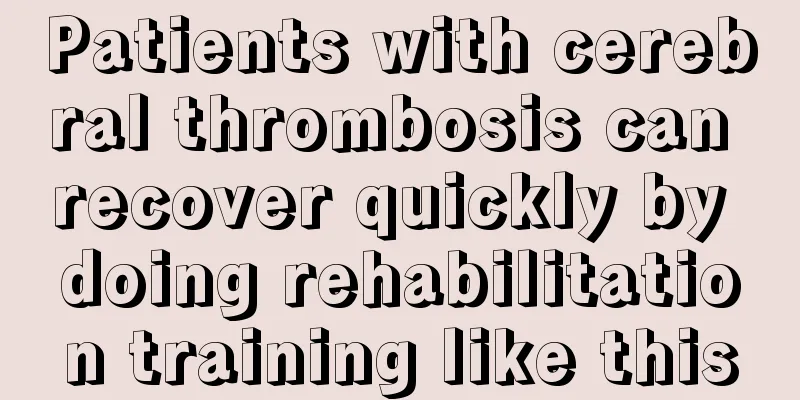Patients with cerebral thrombosis can recover quickly by doing rehabilitation training like this

|
Cerebral thrombosis is a common and frequent disease, which usually requires rehabilitation training to assist in treatment when the disease enters a stable state. Sitting balance training, standing balance training, walking training, stair climbing and wheelchair use training are five simple and effective rehabilitation training methods. Patients with cerebral thrombosis can learn more about them so as to recover their health as soon as possible. 1. Sitting balance training First, bend your knees and sit on the bed with the support of the back frame, gradually remove the support, and put your legs on the edge of the bed. You can also install rails, handles or ropes on the side or head of the bed to help you sit up. Sitting balance training enhances trunk muscle strength (simultaneous contraction) and sitting balance, etc. 2. Position balance training Need support or train on a special double pole, using a cane if possible. When standing, keep your feet about 3 cm apart. First use the healthy limb to hold the weight, then slowly try to use the affected limb, gradually alternating the two feet until you stand firmly. You can also hold on to a stool or other tools and slowly move and walk. 3. Walking training Initially supported by others, gradually transition to walking independently, while paying attention to correcting problems during walking, such as the circular gait of hemiplegic patients. The main movements during training are knee flexion and ankle dorsiflexion. Choose a lighter and tougher crutch with an appropriate length, generally 3 to 5 cm from the armpit to the sole of the foot, or the patient's height minus 40 cm. You can also use a pair of crutches. It depends on the individual and the appropriate length. 4. Stair climbing training When going upstairs, first step up with your healthy foot and then lift your affected foot to the same step as your healthy foot. Do the opposite when going downstairs. If you use crutches, you can first place the crutches on the upper step, then step over with your healthy foot, and finally step over with your affected foot. The movements are the opposite to going downstairs. Sometimes you may feel uneasy when going downstairs, so you can try going downstairs facing backwards. 5. Wheelchair training Initially, the patient is supported and assisted by someone. The assistant stands behind the wheelchair, holds the armrests or back of the wheelchair with both hands, and then steps on the horizontal axis below with his feet to fix the wheelchair. The wheelchair is placed on the patient's healthy side, and the handbrake is engaged when getting up or down. After getting on, the patient is trained to move on the chair, moving forward and backward and rotating left and right. |
<<: I feel a sense of anal drooping and always want to go to the toilet. What's going on?
>>: What to do if anal rupture and bleeding
Recommend
How to identify the early "disguise" of colorectal cancer
With the improvement of living standards, the ext...
What should I do if my cornea is inflamed?
As the saying goes: eyes are the windows of the s...
At what age can a baby drink milk without a pacifier
When babies are young, they absorb nutrition by d...
What sleeping position is less likely to cause snoring?
The small habits in life can have a serious impac...
What are the treatment options for lung cancer? Three treatment methods for lung cancer
Whether it is the emergence of tobacco or the inf...
What is the difference between medical insurance and critical illness insurance?
In real life, health insurance is a type of insur...
How to remove wrinkles from leather shoes? This is the correct way!
In daily life, many people wear leather shoes, es...
Precautions for rectal examination
Digital rectal examination is a commonly used exa...
Can leeks be eaten with shrimps?
A good combination of foods can not only make the...
How to do Gua Sha at home
Gua Sha is a unique traditional treatment method ...
How to peel old water chestnuts?
Water chestnuts are a very common food in our dai...
Count the specific symptoms of prostate cancer patients
Prostate cancer is a common tumor disease that af...
Is small cell lung cancer hereditary? What is the chance of inheritance?
Small cell lung cancer has a certain chance of be...
What is the effect of tanshinone injection
I hope everyone can understand that when using an...
What are the complications of bone cancer
What complications can bone cancer cause? Bone ca...









